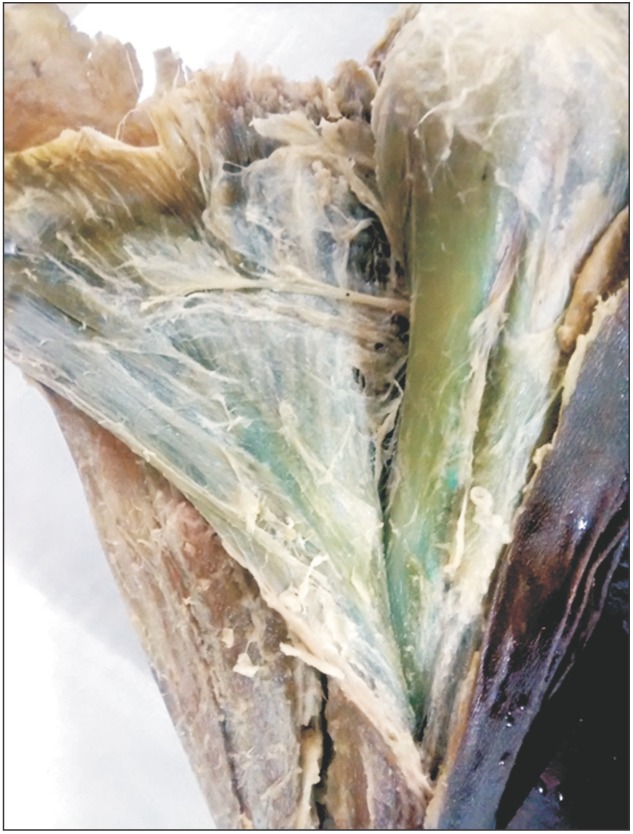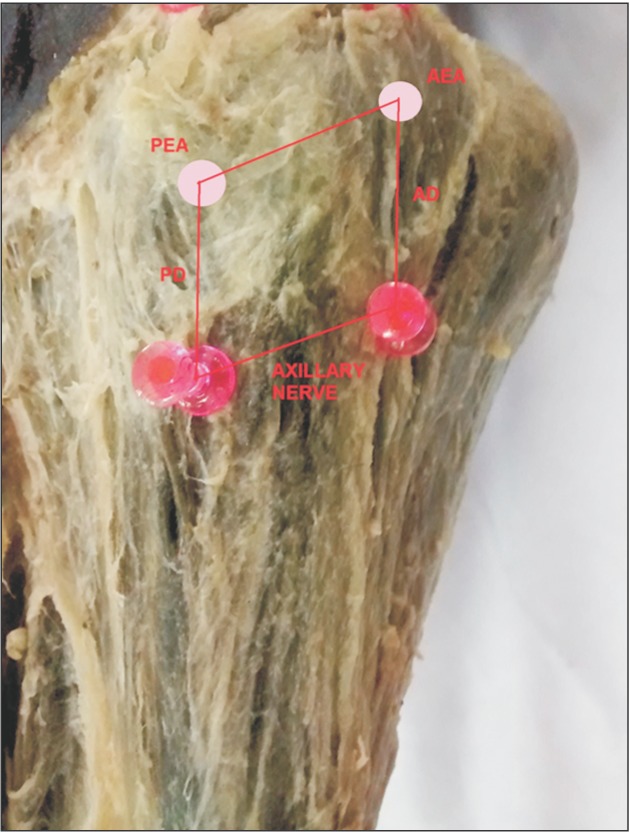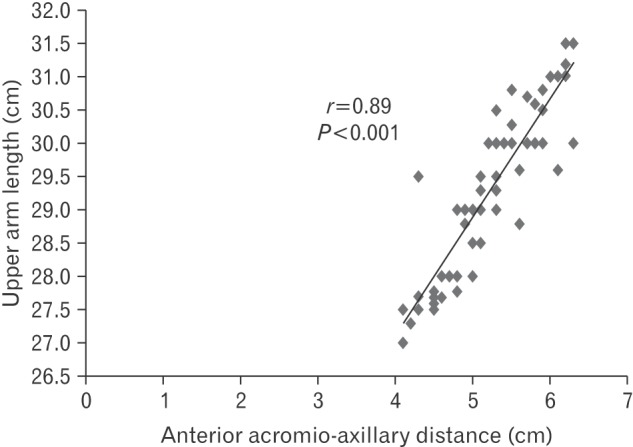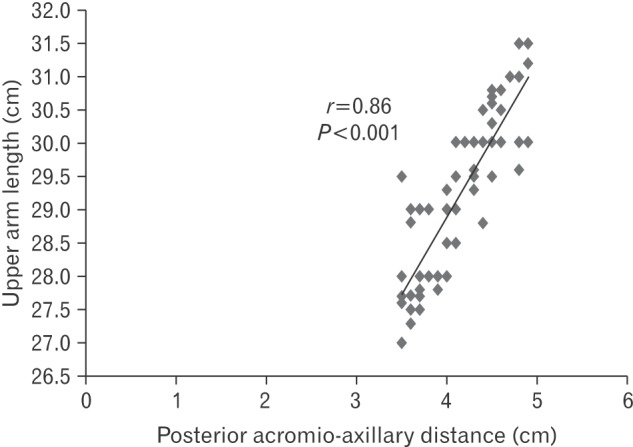Anat Cell Biol.
2018 Jun;51(2):93-97. 10.5115/acb.2018.51.2.93.
Re-definition of position and calculation of safe area for axillary nerve in deltoid muscle with its clinical relevance: a cadaveric study
- Affiliations
-
- 1Department of Anatomy, Government Medical College, Patiala, India. anatomygmcpatiala@gmail.com
- 2Department of Orthopaedics, Maharishi Markandeshwer Institute of Medical Sciences and Research, Mullana, India.
- 3Department of Social and Preventive Medicine, Government Medical College, Patiala, India.
- KMID: 2421172
- DOI: http://doi.org/10.5115/acb.2018.51.2.93
Abstract
- Several authors have made efforts to define the position of the axillary nerve within deltoid muscle and to calculate the so called safe area for this nerve but it still remains a matter of debate. The primary aim of the study was to investigate the acromio-axillary (AA) distance and its correlation with upper arm length. The secondary aim was to re-define the safe area for axillary nerve within deltoid muscle. Sixty shoulders of thirty adult human cadavers were dissected using standard methods. The distance from the anterior and posterior edge of acromion to the upper border of the course of the axillary nerve was measured and recorded as anterior and posterior AA distance respectively. Correlation analysis was done between the upper arm length and AA distance for each limb. The ratios between anterior and posterior AA distance and upper arm length were calculated and mentioned as anterior index and posterior index, respectively. The mean of anterior and posterior AA distance was 5.22 cm and 4.17 cm, respectively. The mean of upper arm length was 29.30 cm. The means of anterior index and posterior indices were 0.18 and 0.14, respectively. There was a significant correlation between upper arm length and both the anterior and posterior AA distance. The axillary nerve was found to lie at variable distance from the acromion. The minimum AA distance was found to be 3.50 cm. So this should be considered as the maximum permissible length of the deltoid split. Upper arm length has strong correlation with both anterior and posterior AA distances. The ideal safe area for the axillary nerve was found to be a quadrangular area above it and the size of which depends on the length of the upper arm.
Figure
Reference
-
1. Johnson D. Pectoral girdle, shoulder region and axilla. In : Standring S, editor. Gray's Anatomy: The Anatomical Basis of Clinical Practice. 40th ed. Edinburgh: Churchill Livingstone;2008. p. 818–822.2. Vathana P, Chiarapattanakom P, Ratanalaka R, Vorasatit P. The relationship of the axillary nerve and the acromion. J Med Assoc Thai. 1998; 81:953–957. PMID: 9916383.3. Hoppenfield S, DeBoer P. Surgical exposures in orthopedics: the anatomic approach. 3rd ed. Philadephia, PA: Lippincott Williams and Wilkins;2003. p. 29–33.4. Abhinav G, Sivaraman B, Matthew N, Grahame JS. A contribution to the calculation of a safe deltoid split. Int J Shoulder Surg. 2008; 2:52–55. PMID: 20300314.5. Hollinshead WH. Anatomy for surgeons. 3rd ed. New York: Harper and Row;1969. p. 344.6. Abbott LC, Saunders JB. Surgical approaches to the shoulder joint. J Bone Joint Surg Am. 1949; 31A:235–255. PMID: 18116561.7. Duparc F, Bocquet G, Simonet J, Freger P. Anatomical basis of the variable aspects of injuries of the axillary nerve (excluding the terminal branches in the deltoid muscle). Surg Radiol Anat. 1997; 19:127–132. PMID: 9381311.8. Hoppenfeld S, deBoer P. Surgical exposures in orthopaedics: the anatomic approach. 2nd ed. Philadelphia, PA: Lippincott Williams & Wilkins;1994. p. 2–214.9. Nassar JA, Wirth MA, Burkhart SS, Schenck RC Jr. Morphology of the axillary nerve in an anteroinferior shoulder arthroscopy portal. Arthroscopy. 1997; 13:600–605. PMID: 9343649.10. Cetik O, Uslu M, Acar HI, Comert A, Tekdemir I, Cift H. Is there a safe area for the axillary nerve in the deltoid muscle? A cadaveric study. J Bone Joint Surg Am. 2006; 88:2395–2399. PMID: 17079396.11. Perlmutter GS. Axillary nerve injury. Clin Orthop Relat Res. 1999; (368):28–36.12. Kessel L. Clinical disorders of the shoulder. Edinburgh: Churchill Livingstone;1982.13. Post M. Complications of rotator cuff surgery. Clin Orthop Relat Res. 1990; (254):97–104. PMID: 2182262.14. Burkhead WZ Jr, Scheinberg RR, Box G. Surgical anatomy of the axillary nerve. J Shoulder Elbow Surg. 1992; 1:31–36. PMID: 22958968.15. Uz A, Apaydin N, Bozkurt M, Elhan A. The anatomic branch pattern of the axillary nerve. J Shoulder Elbow Surg. 2007; 16:240–244. PMID: 17097311.16. Ikemoto RY, Nascimento LG, Bueno RS, Almeida LH, Strose E, Murachovsky J. Axillary nerve position in the anterosuperior approach of the shoulder: a cadaveric study. Acta Ortop Bras. 2015; 23:26–28. PMID: 26327791.17. Gurushantappa PK, Kuppasad S. Anatomy of axillary nerve and its clinical importance: a cadaveric study. J Clin Diagn Res. 2015; 9:AC13–AC17. PMID: 25954611.18. Rockwood CA Jr, Wirth MA. Subluxations and dislocations about the glenohumeral joint. In : Rockwood CA, Green DP, Bucholz RW, Heckman JD, editors. Rockwood and Green's Fractures in Adults. 4th ed. Philadelphia, PA: Lippincott-Raven;1996. 2:p. 1193–1339.19. Kulkarni RR, Nandedkar AN, Mysorekar VR. Position of the axillary nerve in the deltoid muscle. Anat Rec. 1992; 232:316–317. PMID: 1546810.20. Kontakis GM, Steriopoulos K, Damilakis J, Michalodimitrakis E. The position of the axillary nerve in the deltoid muscle: a cadaveric study. Acta Orthop Scand. 1999; 70:9–11. PMID: 10191739.21. Eksioglu F, Uslu M, Gudemez E, Atik OS, Tekdemir I. Reliability of the safe area for the superior gluteal nerve. Clin Orthop Relat Res. 2003; (412):111–116.
- Full Text Links
- Actions
-
Cited
- CITED
-
- Close
- Share
- Similar articles
-
- Branching pattern and morphometry of the axillary nerve
- Reverse shoulder arthroplasty for corticosteroid-induced deltoid myopathy in a patient with systemic lupus erythematosus: a case report
- Axillary Nerve Injury after Swimming with Butterfly Stroke: A case report
- Isolated Injury of the Axillary Nerve Branch to Teres Minor Muscle Following After Traumatic Posterior Instability of Shoulder
- The humeral suspension technique: a novel operation for deltoid paralysis





